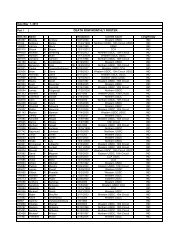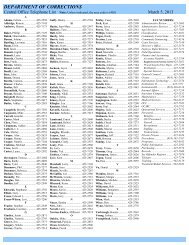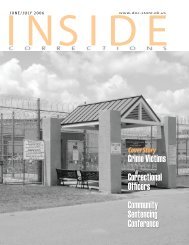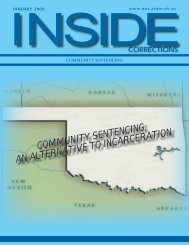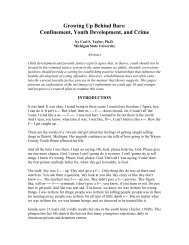Backfire: When Incarceration Increases Crime
Backfire: When Incarceration Increases Crime
Backfire: When Incarceration Increases Crime
You also want an ePaper? Increase the reach of your titles
YUMPU automatically turns print PDFs into web optimized ePapers that Google loves.
<strong>Backfire</strong>: <strong>When</strong> <strong>Incarceration</strong> <strong>Increases</strong> <strong>Crime</strong><br />
by Todd R. Clear, Ph.D.<br />
Florida State University<br />
Abstract<br />
This paper examines various ways in which prison may have inadvertently affected crime<br />
rates. The question is important because, even though levels of imprisonment increased<br />
fivefold since 1973, crime rates have not dropped proportionately during this period. I<br />
argue that the crime-reducing aspects of imprisonment are considerably negated by the<br />
crime-enhancing ones.<br />
The paper focuses on three crime-enhancing effects of imprisonment. First, replacement<br />
of co-offenders may account for the failure of prisons to reduce crime. Replacement also<br />
results in an earlier and more sustained recruitment of young people into criminal<br />
careers. Second, as more people acquire a grounded knowledge of prison life, the power<br />
of prison to deter crime through fear of the unknown is diminished. Extensive realitybased<br />
experience of prisons in certain communities exponentially increases the<br />
significance of this problem. Finally, social factors known to contribute to criminality<br />
such as broken families, inequality, and social disorder increase with high rates of<br />
imprisonment, especially in certain communities.<br />
INTRODUCTION<br />
In the popular point of view, prisons are thought of as crime fighting-devices: exposing<br />
offenders to prison reduces crime. This viewpoint began governing penal policy in the<br />
early 1970s; since then, we have increased the size of our prison population fivefold.<br />
However, the expansion of the penal system has not been accompanied by an equivalent<br />
decrease in crime. The failure of this extraordinary increase in incarceration to produce a<br />
meaningful reduction in crime needs explanation. The purpose of this paper is to argue<br />
that the common view of the prison is simplistic because it fails to account for the<br />
unintended consequences of imprisonment. These unforeseen effects are subtle and, in<br />
some ways, modest, but over time they combine to counteract the positive effects of<br />
prison. A broader, more complete understanding of the effects of incarceration would<br />
enable us to understand the limits of using prison as a crime-prevention strategy.<br />
The debate about incarceration policy has been dominated by an atomistic view of crime-<br />
-that individuals who engage in crime are influenced by personal motivations,<br />
independent of the contexts in which they live. The sole exception to this view is that the<br />
threat of incarceration prevents people from carrying out their illicit desires.<br />
Consequently, decisions to engage in crime are seen as products of the likelihood and<br />
degree of punishment if caught, and little else.
An alternative view of criminal behavior employs a more holistic perception of the<br />
potential offender--as a person who lives in places, interacts with fellow citizens, and<br />
responds to various life circumstances with choices based on a grounded understanding<br />
of the consequences of those choices. The use of prison might affect all of these<br />
contextual elements: the places people live, the social interactions occurring there, the<br />
choices people have available to them, and their understanding of those choices.<br />
The Atomistic Model: <strong>Crime</strong> as a Phenomenon of Individuals<br />
Throughout this century, conversation about crime policy has been dominated by the idea<br />
that individual offenders require reform or rehabilitation. The belief now in vogue is that<br />
they require control. 1 Of course, these approaches differ in several important respects, but<br />
they share a common analytic foundation: <strong>Crime</strong> and its control are best understood in<br />
regard to the thoughts and emotions of specific individuals who commit crimes or want to<br />
commit crimes.<br />
These views might all be termed "atomistic" 2 because offenders are seen as individual<br />
actors who behave largely in isolation from their environments. Therefore, rehabilitation<br />
models have always treated the offender as the unit of analysis, to be diagnosed or<br />
classified for correctional interventions based on his or her individual characteristics.<br />
Similarly, the groundbreaking criminal career model (Blumstein, Cohen, Roth, & Visher,<br />
1986) describes the offender's life as though it were self-contained system, bounded by<br />
age of onset, duration, rates of behavior, and dates of desistence. 3 The tendency to view<br />
crime as a phenomenon defined by wayward individuals and their desires is not only<br />
ingrained in penology, it is reinforced in public consciousness by the popular media's<br />
focus on individual criminal events as news stories.<br />
The dominant viewpoint is atomistic in another sense: Incarcerating specific offenders is<br />
considered to be a self-contained process--affecting that offender and almost nobody else.<br />
The walls of the prison stand symbolically as a black box into which citizens disappear<br />
for a time and later emerge, changed or not. The number of black boxes in existence and<br />
the frequency of experiences within them are, therefore, important only for the<br />
individuals who go through the process. This perspective ignores the potential impact of<br />
incarceration upon families, communities, economics, and politics. 4<br />
A full-scale review of the individualistic model is not necessary here (see Hudson, 1987),<br />
except to say that the flow of ideas about criminals led, in the 1970s, to speculations<br />
about the nature and impact of the individual criminal career. The initial development of<br />
the individual criminal paradigm (Shinnar & Shinnar, 1975) was broadly coterminous<br />
with the growing use of imprisonment, which started its upward trend in 1973 (Clear,<br />
1994). The notion that criminal careers could be controlled through incapacitation surely<br />
contributed to the acceptability of the unprecedented growth in prison populations.<br />
The Central Quandary: Punishment and the Criminal Career Model
A profound penological paradox of the twentieth century is this: between 1973 and 1995,<br />
prison populations quintupled in size and incarceration rates quadrupled, yet crime rates<br />
have remained high.<br />
<strong>Crime</strong> rates. There is disagreement about what exactly has happened to crime rates over<br />
the last 25 years. According to the Uniform <strong>Crime</strong> Reports (UCRs) compiled by the FBI,<br />
index crime is up about one-third since 1970. FBI data show that between 1970 and 1980,<br />
there were two periods of steep increases, bounded by short periods of slight decline. A<br />
period of gradual decline in the first half of the 1980s was followed by a longer gradual<br />
increase in crime. After 1991, FBI data demonstrate another period of declining crime.<br />
By contrast, the National <strong>Crime</strong> Victimization Survey (NCVS), which gathers reports of<br />
crime from a sample of citizens, reported stable victimization rates for violent crimes<br />
since 1973. Property crime was seen to be stable during the 1970s, but dropped by about<br />
one-third in the 1980s.<br />
Depending on how one does the counting, crime has either gone up, stayed stable, or<br />
declined during the period of booming prison populations. Thus, firm conclusions are<br />
difficult to reach. Many criminologists believe that the drop in property crime shown in<br />
the NCVS data is due to the three forces: the decline in the number of citizens in crimeprone<br />
age groups (Steffensmeier & Harer, 1991), increased use of crime prevention<br />
devices in homes (Felson, 1993), and the replacement of property crime by more<br />
lucrative drug trade (Blumstein, 1993). Despite what is not yet known, it must be<br />
conceded that more than 20 years of prison growth have not been accompanied by a<br />
consistent, complementary drop in crime.<br />
How could this happen? If crime is a result of the aggregate actions of a large number of<br />
active criminals, then locking up more of them should reduce crime; locking up a lot<br />
more of them should reduce crime dramatically.<br />
Numerous researchers have advanced this argument. A lengthy review of these studies is<br />
not needed, 5 but a description of a few of them is instructive. Petersilia, Greenwood, and<br />
Lavin's (1977) study of the self-reported criminal histories of serious felons led them to<br />
conclude that the average offender committed more than 200 crimes per year. Greenwood<br />
(1982) estimates that an incapacitation policy could reduce robbery rates in California by<br />
up to 20%. Zedlewski's (1987) analysis of imprisonment indicates that locking up more<br />
offenders would not only reduce crime but would save money as well. DiIulio and Piehl<br />
(1991) argue similarly that active offenders commit so many crimes that, on balance,<br />
imprisonment pays for itself in cost savings.<br />
These studies illustrate the atomistic tradition of modeling crime. Each assumes that an<br />
individual's propensity for criminal behavior is detached from any social context, such as<br />
politics or the economy, and is merely a function of the possible or likely punishment.<br />
The external validity of this approach is easily tested. As Zimring and Hawkins (1991)<br />
point out, if these models are sound, then the stupendous growth in prison populations
since the 1970s should have reduced crime so much that today we would have a negative<br />
crime rate. Since a negative crime rate is obviously impossible, it follows that something<br />
is wrong with the atomistic models.<br />
The crime-age curve. A central problem with the incapacitation paradigm is the fact that<br />
crime is largely a youthful act, especially of male adolescents (Gottfredson & Hirschi,<br />
1990), and prison is reserved for adult men in their 20s and 30s. 6 Proponents of<br />
incarceration respond in two ways: This fact justifies using incarceration earlier in an<br />
offender's career, and older criminals are the high-rate offenders, who would be<br />
committing a large number of crimes if they were free. Each argument deserves<br />
exploration.<br />
Earlier incarceration. There are two problems with incarcerating youthful offenders.<br />
First, it is exceedingly difficult to target those who will become persistent offenders<br />
(Gottfredson & Gottfredson, 1986; Monahan, 1981). While arrest rates are high for lateadolescent<br />
males, their desistence rates are also high. This means that a broad policy of<br />
incarceration for youthful offenders will inevitably incarcerate a large number of<br />
offenders who, without imprisonment, would quickly outgrow criminal behavior patterns.<br />
The second problem is that incarcerating low-risk youth would probably have detrimental<br />
effects. Exposing young males to the threats and indignities of prison may make it less<br />
likely for them to outgrow their criminal behavior at the usual pace. Indeed, Golub's<br />
(1990) research suggests that normal patterns of desistence from crime are interrupted<br />
and perhaps delayed by typical terms of incarceration. If this is true, the acceleration of<br />
criminal careers caused by imprisonment would wash out at least some of the crimeprevention<br />
effects of prison.<br />
High-rate offenders. One of the most consistent findings in criminological literature is<br />
that a small percentage of offenders commit the greatest percentage of crime. <strong>When</strong> we<br />
hear the common litany that seven percent of offenders commit 70% of the crimes, it<br />
reflects patterns that are well established by research (Farrington, 1986; Greenwood,<br />
1982; Wolfgang, Figlio, & Sellin, 1972) and generates what might be called a 7-70<br />
theory of the prison. 7 By the time offenders reach prison, they have passed a series of<br />
examinations by the justice system, meaning that they are probably the worst of the bad-high-rate,<br />
serious offenders. Thus, locking them up prevents disproportionately more<br />
crime.<br />
However, policies of incarceration growth are not arguments in favor of incarceration<br />
instead of its absence; they are arguments for more incarceration than at present--either<br />
incarcerating a higher proportion of offenders than we do now, or locking the current<br />
ones up for a longer period of time, or both. If the former strategy--lock more people up-is<br />
chosen, increasingly prison will be used for lower-rate offenders because, according to<br />
the argument, the higher-rate offenders are already being apprehended and imprisoned.<br />
The latter tactic implies that people will be incarcerated into their years of natural<br />
desistence from crime. 8
We already lock up a million offenders. Do we have all the wrong ones? Since 1973, we<br />
have increased the prison population by 800,000 offenders. <strong>When</strong> we remove active<br />
offenders from society, crime rates do not drop nearly as much as we would expect. This<br />
suggests that street criminals are being replaced, that increases in imprisonment lead to<br />
increases in crime, or some combination of the two.<br />
Replacement<br />
Albert Reiss (1988) was the first scholar to consider how replacement of criminals may<br />
affect crime rates during periods of high incarceration. He coined the term co-offending<br />
to refer to the fact that a large percentage of crime is committed by offenders behaving in<br />
groups. This is particularly characteristic of drug crimes and violent street crimes, such as<br />
robbery. The question is the degree to which the apprehension and incarceration of one<br />
member of a co-offending group ends the criminality of the group or merely causes the<br />
group to recruit a new member. A related question is the degree to which the recruitment<br />
process enlists persons who otherwise would not have been involved in the criminal<br />
behavior. 9<br />
Ekland-Olson, Kelly, Loo, Olbrich, & Eisenberg (1993) have used the term vacancychains<br />
to refer to the process by which replacement may cancel out the crime-prevention<br />
benefits of incapacitation. This is particularly pertinent to drug markets. The<br />
incarceration of drug offenders, in the face of a stable demand for drugs, creates job<br />
openings in the drug delivery enterprise and allows for an ever-broadening recruitment of<br />
citizens into the illegal trade. This has led to speculation that policing and incarcerating<br />
drug offenders results in greater involvement of younger males as workers in the drug<br />
market. Replacement theories are especially applicable to street gangs. <strong>When</strong> one or two<br />
gang members is arrested, the criminality of the remaining gang members is unaffected.<br />
Gang researchers find that up to a certain threshold, arrests do not have much impact on<br />
gang criminality.<br />
<strong>Crime</strong> and the Prison<br />
In the end, however, replacement cannot fully explain the imperviousness of crime to<br />
increases in imprisonment. The stability of crime rates at high levels despite vast<br />
increases in the use of the prison is simply too profound to be a product of a single social<br />
process.<br />
This fact has led some to speculate that prison itself has criminogenic properties. On the<br />
surface, the idea that the use of incarceration exacerbates crime seems implausible.<br />
Americans are so accustomed to thinking of prison as a last-ditch means of controlling<br />
crime, the proposal that it may increase crime strikes us as almost absurd.<br />
Yet there is a powerful sociological tradition supporting this type of inquiry. Critical<br />
social theorists such as Michel Foucault (1977) have argued that prison invented<br />
delinquency, in the sense that the intellectual language underlying the concept of the<br />
individual criminal was one of the products of the formation of the prison. Foucault went
on to explain that prison needs to fail in its task of controlling criminality if it is to<br />
survive as a prominent social function. 10<br />
One need not adopt Foucault's perspective, though, to confront the paradox of the prison.<br />
A growing interest among sociologists in reflexive analysis (Bourdieu, 1992) provides a<br />
platform for thinking about the social location of the prison and its growth. This<br />
analytical point of view situates prison within human experience and within social life in<br />
the United States. One therefore expects prison to have various effects on individuals<br />
inside and outside its walls, and that these effects change the way people on the outside<br />
understand the social significance of prison. In short, one sees prison as influencing<br />
groups other than prisoners. Perhaps these effects are contextual constraints on prison as<br />
a crime control device.<br />
The advantage of this framework is that it avoids the errors of atomistic thinking. Prisons<br />
and the citizens housed there are no longer seen as isolated from other aspects of society.<br />
Therefore, dramatic changes in the extent of imprisonment, which occurred in the United<br />
States in the last 25 years, can be interpreted both as a product of shifting social forces<br />
and as a provocation of social change.<br />
Social Patterns in <strong>Crime</strong> and Imprisonment<br />
Prison use can affect crime directly, by influencing current prisoners and potential<br />
offenders, or indirectly, by altering the structures and functions that in turn affect such<br />
individuals. And, while some effects will be positive, others will be negative. Indeed,<br />
prisoners are complex in their impacts; some benefits are canceled out by other deficits.<br />
Most research on prison focuses on the direct ways that incarceration reduces crime; this<br />
work is mostly contained within the tradition of crime control studies. (Farrington,<br />
Langan, & Wikstrom, 1994; Zimring & Hawkins, 1995). It is fair to say that for some<br />
offenders, the prison experience almost certainly deters future criminal behavior.<br />
However, the important consideration is the extent of the direct crime-prevention affects<br />
of imprisonment. There is considerable debate on this issue. Prison enthusiasts have<br />
argued for average incapacitation effects that are substantial. For instance, Shinnar and<br />
Shinnar (1975) propose that an increased use of incarceration would produce a 20%<br />
reduction in crime in New York. Zedlewski (1987) asserts that for each newly imprisoned<br />
offender, 187 crimes are averted each year. DiIulio and Piehl estimate that as many as<br />
100 crimes are avoided for each additional year of imprisonment. We have already seen<br />
the limited external validity of these estimates. The flaws in these studies have to do with<br />
their failure to account for replacement and their use of mathematical averages rather<br />
than medians in determining offending rates. 11<br />
Researchers who have tried to account for replacement and for overestimates of crime<br />
rates among imprisoned populations arrive at much more modest crime-prevention<br />
estimates. Cohen and Canelo-Cacho (1994) estimate that the reduction in violent crime<br />
due to increases in imprisonment of violent offenders since 1975 has been no more than
10%. Spelman (1994), who reanalyzed the original RAND data and methods used by<br />
Zedlewski and DiIulio, indicates that current incarceration rates avert perhaps no more<br />
than 8% of crimes. Both studies estimate that further increases in the use of imprisonment<br />
would yield diminishing returns.<br />
The complexity of the modeling appears to influence the results. Those studies which<br />
make more complicated calculations and factor in more contingencies consistently<br />
estimate lesser effects, overall. That is, the more simplistic the study, the more optimistic<br />
its claims.<br />
Unfortunately, few research studies have considered the way that prison use might<br />
indirectly reduce crime. Studies on indirect effects might posit a socialization effect, so<br />
that when offenders are removed from the streets, the people who remain become less<br />
likely to commit offenses. In a parallel situation, it is plausible that removing a child<br />
abuser from the home decreases the criminogenic consequences of the abuse experiences<br />
(Widom, 1994). There are other indirect ways imprisonment could reduce crime. For<br />
example, if citizens feel safer because prison populations are larger, they might be more<br />
likely to walk the streets; their presence as guardians would then reduce crime (Felson,<br />
1994).<br />
The remainder of this paper is devoted to an analysis of the ways in which prison use<br />
might increase crime, either directly or indirectly. Few studies have considered this<br />
question, and so the discussion proceeds largely by conjecture.<br />
The Prison as Directly Self-Defeating<br />
In theory, prison suppresses crime because prison is an authentically unpleasant and<br />
stigmatizing experience that people seek to avoid. These effects are dependent on images<br />
of prison--how people understand the prison experience personally and socially. People<br />
think of imprisonment and imagine what it would be like to be there, what it would mean<br />
to have a record. These images inform the person's view of the pain and stigma that<br />
would result from being imprisoned.<br />
There are two ways people form impressions of a social experience such as prison-personal<br />
experience and secondhand knowledge. If the nature of these two sources were<br />
to change, perhaps the images and, consequently, their impacts would also change.<br />
It is certainly the case that public debate projects a changed view of prison's<br />
unpleasantness. A national movement to strip prisons of television sets and weight lifting<br />
privileges is motivated by what appears to be a conviction that prisons are simply not<br />
tough enough. The belief that prison time is easy compared to life on the streets is widely<br />
shared. It has been voiced by politicians such as Governor William Weld and Senator<br />
Phil Gramm, researcher Joan Petersilia (1990), and even civil rights advocate Jesse<br />
Jackson. While each commentator would suggest a different course of action in response<br />
to this observation, it is interesting nonetheless that they agree our prisons are "not so<br />
bad." 12
This is an important issue because, if people's images of the prison are less severe, then<br />
the associated desire to avoid the experience can be expected to diminish. Where did the<br />
remarkable idea that our prisons are places of comfort originate?<br />
There are several sources. Two decades of prisoner rights litigation created a public belief<br />
that prisoners can effectively resist arbitrary or brutal treatment. New prisons do not<br />
resemble menacing, dungeon-like structures with unscaleable walls; instead, they are<br />
attractive brick edifices surrounded by fences. Popular media portrayals of prison life<br />
may also contribute to a growing public conviction that prisons are not harsh.<br />
But there is another possibility: The increased use of prison over the last 20 years may<br />
have reduced the negative view of prison. The more often the sanction of imprisonment is<br />
employed, the less it deters.<br />
It is plausible that deterrence is linked to mystery. People imagine a harsh and forbidding<br />
environment in which brutal and victimizing experience is commonplace. They also<br />
imagine the shame and humiliation that follows others learning of their prison history.<br />
These are vivid images, but the reality of prison experience, more widely distributed<br />
among the populace, may soften this mental portrait.<br />
James Finkenauer's (1982) study of Rahway Prison's "Scared Straight" program<br />
illustrates this idea. The program involved sending first-time juvenile offenders to meet<br />
with a group of lifers, who would regale them with terrifying stories about prison and<br />
threatening behavior about "what I am gonna do to you if you end up here." The theory<br />
behind the program was that these juveniles, dabbling in delinquency, would be so<br />
frightened by the crusty lifers' tales that they would be "scared straight"-- frightened into<br />
obedience with the law in order to avert the inevitably horrifying prison experience.<br />
Finckenauer found that the kids who went through the program actually did worse than a<br />
comparison group not exposed to the program. The kids in his study were exposed to the<br />
most hostile version of prison life imaginable, and yet far from being scared straight, they<br />
were likely to keep offending. Several explanations of this finding are possible, but the<br />
most obvious is that exposure to the brutalizing nature of prison normalizes the<br />
experience and provides images of survival to replace pre-existing images of doom. The<br />
youth now have a grounded experience of prison at its most brutal, and of tough men not<br />
only surviving the experience but thriving within it. Finally, that the youth themselves<br />
survived their prison experience diminishes the mystery of prison life. Popular American<br />
images of the prison were dominated by the "big house" myth and Edward G. Robinson<br />
tough-guy characters. Real-life experience replaces popular ideation with grounded<br />
reality.<br />
In 1973, when there were only 200,000 prisoners nationwide, true-life prison images<br />
were comparatively rare. Today, with a million prisoners, far larger numbers of people<br />
have real-life knowledge of the prison experience. In counting the grounded<br />
knowledgeable, it is important to go beyond those incarcerated, as the "scared straight"<br />
story illustrates. The real-life experience of each prisoner grounds an understanding of
the prison for each parent, child, and loved-one known to that prisoner. If each prisoner's<br />
personal experience reaches ten others, then the 1973 prison population reflected two<br />
million knowledgeable consumers on any given day, while today's figures indicate ten<br />
million.<br />
Of course, this growth in grounded understanding of prison is concentrated in certain<br />
communities. It has been estimated that 80%t of all Rikers Island inmates come from<br />
seven neighborhoods in New York City (Clines, 1992). 13 The children, mothers, brothers,<br />
and sisters of prisoners in these neighborhoods are some of the nation's most wellinformed<br />
consumers of the "scared straight" prison lecture. They know that men who go<br />
to prison eventually come out and begin their lives again. They know and can repeat the<br />
stories of prison technique--what to do in prison in order to survive the experience. They<br />
know that the people in prison include some brutal and repulsive types as well as people<br />
like their father or brother. Instead of a dark fear of prison, they have a grounded image<br />
of what day-to-day life there entails. This is almost certainly not a pleasant image, but it<br />
is reality-based. They have an expectation of survival of the physical and emotional<br />
aspects of prison life. 14 Just as the fear of physical deprivation may be lessened by<br />
knowledge, so is the prison's stigmatizing capacity. If nearly everyone has a brother,<br />
father, or uncle who has gone to prison, the mortification one feels at the experience is<br />
less powerful. The implications of this fact are ominous once the differential influence of<br />
the penal system is recognized: Some estimate that one in three of all African-American<br />
males aged 20 to 29 are currently under control of the criminal justice system (Mauer,<br />
1995). In general, negative reinforcement, used frequently, loses some of its sting. The<br />
more prison is used, the more real are the images people have of prison. As these images<br />
are normalized, their mythological potency is diminished and so is the prison's power to<br />
deter criminal behavior. 15<br />
Some who have commented that today's prison life is "not so bad" have in turn argued for<br />
making the conditions more brutal. If my analysis is correct, they are fighting a losing<br />
battle. It is not the actual brutality of prison life that deters, it is imagining the prison<br />
experience. No matter how brutal--and today's prisons can be undeniably cruel places-the<br />
widespread use of prison will continue to create growing numbers of informed<br />
consumers who know people who have survived and count them among friends and<br />
family.<br />
Indirect Ways in Which the Prison May Increase <strong>Crime</strong><br />
Outside an atomistic perspective, we can question whether the expanded use of<br />
incarceration may exacerbate the social conditions of crime, thus contributing indirectly<br />
to increases in crime. Broadly, three sets of social forces may be negatively affected by<br />
prison: families and children, neighborhood order, and social inequality.<br />
Families and children. It is well established that family dissolution can adversely affect<br />
children. Therefore, the incarceration of a parent will predict child difficulties. The few<br />
studies of this phenomenon document the theoretical and practical significance of the
problem (see, for example, Gabel, 1992; Lowstein, 1986) and the fact that it differentially<br />
affects families of color (King, 1993).<br />
The effects of incarceration on children and families are emotional and material. Material<br />
effects include problems that result from the loss of children care and financial support.<br />
In the process of responding to the disruption, secondary changes may also occur such as<br />
address or school changes, changes in the composition of the family unit, and reductions<br />
in financial security.<br />
The emotional consequences are less obvious but potentially more significant. Depending<br />
on the age of the child, removal of a parent to prison may promote acting out, especially<br />
in school. Children may feel shame, humiliation, and a loss of social status. They may<br />
come to distrust or even despise the symbols of authority (laws and the state) that have<br />
removed their parent. The chances of new parenting combinations increase, and this may<br />
mean more inconsistent or fractious relationships and disciplinary practices with children.<br />
Some might argue that removing a criminal parent likely removes an abusive or abusing<br />
influence from the home. The net gain of removing such a parent may outweigh the net<br />
loss, but it may not. Nevertheless, a child will respond in a variety of ways, some of<br />
which are negative. Specifically, the future criminality by children of incarcerated parents<br />
is worth exploring. Certainly, poor school performance, unsupervised free time, financial<br />
strain, decreased contact with adults, and suppressed anger are precursors of delinquency<br />
(Wright & Wright, 1994).<br />
Neighborhood order. Felson (1994) has repeatedly pointed to the link between capable<br />
guardians and delinquency prevention. A number of variables influence the availability of<br />
capable guardians, including: the availability of people, especially adults; the degree of<br />
social interaction in public settings; and the size and nature of housing. These are some of<br />
the factors referred to as "social capital" (Wilson, 1978, 1987).<br />
Expanded use of the prison negatively influences the availability of guardians and the<br />
level of social capital. <strong>Incarceration</strong> removes persons who could provide surveillance<br />
value in neighborhoods. And, fewer adults means less social interaction. The entry and<br />
exit of adults from families means that the economic circumstances of those families<br />
change--this in turn promotes relocation, which creates transitory populations and often<br />
less integrated neighborhoods.<br />
The neighborhoods from which people (especially young men) are removed to prison are<br />
the places they return upon their release from prison. These ex-offenders are more likely<br />
to be unemployed or underemployed, adding to the local unemployment rate and the<br />
chronic difficulties ex-convicts face in finding and retaining work. In short, the more the<br />
prison system grows, the more it contributes to the decay of neighborhoods outside its<br />
walls--inner-city locations already struggling with the strains of economic and social<br />
disorder.
Economic inequality. America is a nation in which the distance between the wealthy and<br />
the poor has been rapidly increasing for nearly 20 years 16 (Bradsher, 1995). The role of<br />
inequality in crime is well-established (Braithwaite, 1979), as is its role in punishment<br />
(Box, 1987). Expanding the prison system aggravates socioeconomic inequalities in two<br />
main ways: imprisonment narrows the life-chances of persons exposed to it and indirectly<br />
results in shifts of economic resources from urban settings to other locations.<br />
It is well-known that imprisonment damages employment possibilities, though the degree<br />
of damage is disputed. Studying arrests, Freeman (1992) found large and lasting<br />
reductions in earning potential; Grogger (in press) on the other hand, found moderate,<br />
short-lived effects. Hagan (1993) argues that the relationship between crime and<br />
unemployment is embedded in elements of the larger social structure. He suggests that<br />
the impact of a prison sentence on a person's earning power has to be understood in terms<br />
of the way it situates the former prisoner in economic and social networks. Crutchfield<br />
(1995) has found that the greater involvement of minorities in marginal employment<br />
makes them more susceptible to criminal behavior and more subject to the damage that<br />
occurs from fluctuations in labor markets. Whatever the perspective, the fact remains that<br />
once a person has been imprisoned, that person's economic potential is, on average,<br />
diminished.<br />
These effects of incarceration are probably small compared to the economic relocation of<br />
resources. Each prisoner represents an economic asset that has been removed from that<br />
community and placed elsewhere. As an economic being, the person would spend money<br />
at or near his or her area of residence--typically, an inner city. Imprisonment displaces<br />
that economic activity: Instead of buying cigarettes and snacks in a local deli, the<br />
prisoner makes those purchases in a prison commissary.<br />
The removal of the prisoner may represent a moderate loss of economic value to the<br />
home community, but it is a boon to the prison community. Each prisoner represents as<br />
much as $25,000 in income for the community in which the prison is located (McDonald,<br />
1989), not to mention the value of constructing the prison facility in the first place. This<br />
can be a massive transfer of value; a young male worth a few thousand dollars of support<br />
to children and local purchases is transformed into a $25,000 financial asset to a rural<br />
prison community. The economy of the rural community is artificially amplified, while<br />
the local city economy is artificially deflated.<br />
Of course, there are other ways that the prison may increase relative disadvantage.<br />
Financial loss suffered by children and partners of the imprisoned, long-term damage<br />
caused by interruptions in the normal life cycles of these families, and effects on the<br />
social status of ex-convicts also contribute to a legacy of economic inequality. The fact<br />
that prison experiences are concentrated in a handful of neighborhoods targets those<br />
places as especially harmed by the expanded use of incarceration. Thus, it is not<br />
surprising to discover that the place a person goes to when released from prison is a good<br />
predictor of the likelihood that the person will remain arrest free (Gottfredson & Taylor,<br />
1986).
Prospectus for a Research Agenda<br />
This analysis has raised questions about the ability to reduce crime merely by increasing<br />
our use of imprisonment. The argument has two general thrusts: first, the nature of crime<br />
poses structural limits to the crime prevention effects of prison; second, as imprisonment<br />
is used more widely, it begins to backfire by directly and indirectly enhancing the forces<br />
that promote criminal behavior. Each of these two themes deserves research inquiry.<br />
The structural limits of incarceration. Although replacement and the age-crime curve<br />
have received considerable attention from researchers as ways of modeling criminal<br />
behavior, less attention has been paid to how these effects can illuminate the limits of<br />
incapacitation. Spelman (1994) has shown how important these dynamics are for<br />
estimating incapacitation effects--minor changes in the assumed magnitude of these<br />
effects result in profoundly different estimates of incapacitation outcomes. Better<br />
knowledge of the true dimensions of these effects will increase our understanding of the<br />
limits of incarceration.<br />
It is now becoming clear that different types of crime have different patterns of<br />
replacement and age-rate deterioration. What further complicates this problem is that<br />
most offenders, especially the most active ones, do not specialize in certain offenses<br />
(Gottfredson & Gottfredson, 1992). Replacement effects are best studied through<br />
ethnographic approaches that follow youth groups over time and record the coming and<br />
going of criminally active group members. The National Institute of Justice is currently<br />
sponsoring studies that question what happens to a group's overall level of criminality<br />
and its recruitment practices when a member is incarcerated.<br />
Once these studies have fleshed out the dynamics of replacement in youth crime, the next<br />
step is to estimate how replacement affects overall crime. For example, if 80% of youth<br />
burglary is subject to replacement and 60% of burglaries are by youth, then nearly half of<br />
all burglaries that would otherwise be prevented by incarceration are replaced.<br />
Additionally, the lifetime contributions to crime of the newly recruited offenders need to<br />
be included in the estimates.<br />
The age-crime curve as a limit on incarceration can also be modeled, and indeed a<br />
number of criminal career researchers have tried to do just that with varying success<br />
(Blumstein, Cohen, Roth, & Visher, 1986). These models need to become more complex.<br />
They should factor in how time in prison may enhance criminal careers and retard<br />
ordinary aging out rates for some offenders.<br />
The indirect effects of incarceration. A second set of studies should focus on how the<br />
prison promotes conditions in families and communities that are thought to foster<br />
criminal behavior. Such a study might take the following form.<br />
Within a single city, two neighborhoods with high incarceration rates would be selected:<br />
one with a large concentration of people of color and the other with a more racially
integrated population. Two comparison low-rate neighborhoods would also be chosen.<br />
The study would be designed to compare the neighborhoods in terms of several variables:<br />
• Among a sample of elementary school children, what proportion experience<br />
parental absence due to incarceration? How are the experiences interpreted and<br />
explained? What is the impact on parental supervision during off-school hours?<br />
• Among a sample of middle school children, how accurate is their knowledge of<br />
prison life? How do youth, especially males, describe time in prison? On what do<br />
they base their description?<br />
• Among a sample of high school youth, how many have reality-based experiences<br />
of imprisonment-- from close family members or others? How do they describe<br />
prison; how much fear of imprisonment do they report?<br />
• Within a sample of households, what is the experience of incarceration? What is<br />
the average financial impact of imprisonment on a family and aggregate effect on<br />
neighborhood finances?<br />
Together, these questions should provide a rough measure of the effect of living in a<br />
high-incarceration neighborhood. This measure could then be used to estimate the<br />
magnitude of the negative effects of incarceration growth--in other words, the backfire.<br />
FOOTNOTES<br />
1 For a brief period in the 1970s, a "reintegrative" ideal, which took into account not only<br />
offenders but the communities in which they live, was prominently debated (O'Leary &<br />
Duffee, 1971). The ascendance of the theory of reintegration was short-lived.<br />
2 According to Webster's, an "atomistic" view is one which sees a phenomenon as being<br />
"made up of a number of unrelated elments"; the faith in "atomism" is the belief in a<br />
"theory that the Universe is made up of tiny, simple, indivisible particles that cannot be<br />
destroyed."<br />
3 Both the rehabilitation and control models consider the affects of various individual<br />
characteristics, but both focus on understanding individual offenders as the key to<br />
knowing about crime at large.<br />
4 There is an important, and ironic, exception to this general rule: From the atomistic point<br />
of view, deterrence means that when the state punishes person X, other persons are<br />
unaffected by that punishment in every way except in calculations of the desirability of<br />
engaging in crime.<br />
5<br />
Zimring and Hawkins (1995) have provided an excellent review of the literature in<br />
support of the incapacitative ideal.
6 In the United States, the peak arrest age is mid to late teens, whereas the peak age for<br />
entering confinement is early to mid 20s.<br />
7 It should be noted that some commentators have thought the "7-70 rule" refers only to<br />
active offenders, meaning that 7% of criminals commit 70% of all crime. This is not the<br />
case. Dr. Marvin Wolfgang's studies found that 7% of boys born in Philadelphia in 1958<br />
were responsible for 70% of the crimes committed by the entire group.<br />
8 It may be argued, as some have done (DiIulio & Piehl, 1991; Zedlewski, 1987) that even<br />
though the crime prevention benefits diminish with expanded prison growth, they still<br />
remain substantial. This claim is based on accepting that current policies are, in fact, as<br />
beneficial as some have asserted. I will consider this question in more detail later in this<br />
paper. My point here is that even if current claims are reasonable--and I do not agree that<br />
they are--it does not follow that expanding the current policy of high rates of<br />
imprisonment will produce proportionately greater benefits in crime reduction.<br />
9 The recruitment of a replacement offender can be a double loss for crime control. Not<br />
only do the crimes continue unabated, but a novice who might never have entered the<br />
criminal lifestyle (or who would have been delayed entry) is exposed to patterns of<br />
offending, and educated as an offender.<br />
10 Non-Marxist analysis has also allowed social scientists to take critical account of social<br />
institutions. Interactionists such as Mauss (1975) and Erikson (1966) describe social<br />
problems such as crime in functional terms, and in so doing borrow heavily from the<br />
Durkheimian tradition of analyzing the social functions of deviance.<br />
11 By using averages, the estimates assume that the extremely high rate offenders are as<br />
frequent among active offenders in the general population as they are in samples of<br />
imprisoned offenders. This is not a plausible assumption.<br />
12 Weld and Gramm would clearly prefer an increase in penal severity while Petersilia and<br />
Jackson surely would not agree. In using the phrase "not so bad," I want to emphasize<br />
that it is a perception of reality reported here, not actual experience.<br />
13 Rikers Island is a large correctional facility serving New York City.<br />
14 It is important to emphasize that normalization of prison life is only one of the<br />
emotional responses people will have knowing someone who is incarcerated. The<br />
reactions to an incarcerated loved one are likely to include anger at the system, personal<br />
shame, loving support, and rejection.<br />
15 At first blush, this point seems to directly contradict the reliance of deterrence theory on<br />
certainty of punishment, but I think that is a wrong interpretation. The deterrence<br />
argument is based on the perceived certainty of a punishment given an offense. My<br />
comments have to do with the perceived onerousness of the punishment, considering that
personal experience with the punishment, which can vary quite independently (or<br />
inversely) with the perception of certainty.<br />
16 According to a study by economist Edward N. Wolff, "We are the most unequal<br />
industrialized country in terms of income and wealth, and we are growing more unequal<br />
faster than any of the other industrialized countries." (Bradsher, 1995)<br />
REFERENCES<br />
Blumstein, A. (1993). Making rationality relevant: The American society of criminology<br />
1990 presidential address. Criminology, 31(1).<br />
Blumstein, A., Cohen, J., Roth, J. A., & Visher, C., (Eds). (1986). Criminal careers and<br />
"career criminals." Washington, DC: National Academy Press.<br />
Bourdieu, P. (1992). Invitation to reflexive sociology. Chicago: University of Chicago.<br />
Box, S. (1987). Recession, crime, and punishment. London: MacMillan.<br />
Bradsher, K. (1995). Gap in wealth in U.S. called widest in west. The New York Times,<br />
April 17, pp. A1, D4.<br />
Braithwaite, J. (1979). Inequality, crime, and public policy. London: Routledge and<br />
Kegan Paul.<br />
Clines, F. X. (1992, December 23). Ex-inmates urge return to areas of crime to help. New<br />
York Times, p. 1FF.<br />
Clear, T. R. (1994). Harm in American penology: Offenders, victims, and their<br />
communities. New York: SUNY Press.<br />
Cohen, J., & Canela-Cacho. J. (1994). Incapacitation and violent crime. In A. J. Reiss, &<br />
J. Roth (Eds.), Understanding and preventing violence, Vol. 4 (pp. 296-338).<br />
Washington, DC: National Academy of Sciences.<br />
Crutchfield, R. D. (1995). Ethnicity, labor markets, and crime. In D. F. Hawkins, (Ed.),<br />
Ethnicity, race, and crime: Perspectives across time and place. Albany: SUNY Press.<br />
DiIulio, J. J., & Piehl, A. M. (1991). Does prison pay? The stormy national debate over<br />
the cost effectiveness of imprisonment. The Brookings Review, Fall, 28-35.<br />
Ekland-Olson, S., Kelly, W. R., Loo, H-J, Olbrich, J., & Eisenberg, M. (1993). Justice<br />
under pressure: A comparison of recidivism patterns among four successive parolee<br />
cohorts. NY: Springer-Verlag.
Farrington, D. (1986). The Cambridge study on delinquency: Long term follow-up.<br />
Cambridge, MA: Cambridge University Press.<br />
Farrington, D., Langan, P., & Wikstrom, P-O. H. (1994). Changes in crime and<br />
punishment in America, England, and Sweden between the 1980s and 1990s. Studies on<br />
<strong>Crime</strong> and <strong>Crime</strong> Prevention, Annual Review 3, (pp. 104-131). Oslo: Scandinavian<br />
University Press.<br />
Felson, M. (1994). <strong>Crime</strong> and everyday life: Insights and implications for society.<br />
Newbury Park, CA: Pine Forge Press.<br />
Finckenauer, J. O. (1982). Scared straight: The panacea phenomenon. Englewood Cliffs,<br />
NJ: Prentice Hall.<br />
Foucault, M. (1977). Discipline and punish: The birth of the prison. New York:<br />
Pantheon.<br />
Freeman, R. B. (1992). <strong>Crime</strong> and unemployment of disadvantaged youth. In A. Harrell,<br />
& G. Peterson (Eds.), Drugs, crime, and social isolation: Barriers to urban opportunity.<br />
Washington, DC: Urban Institute.<br />
Gabel, S. (1992). Children of incarcerated and criminals parents: Adjustment, behavior,<br />
and prognosis. Bulletin of American Academic Psychiatry Law, 20, 33-45.<br />
Golub, A. (1990). The termination rate of adult criminal careers. Pittsburgh: Carnegie<br />
Mellon.<br />
Gottfredson, S. D., & Gottfredson, D. M. (1986). Accuracy of prediction models. In A.<br />
Blumstein, J. Cohen, J. A. Roth, & C. Visher, (Eds.), Criminal careers and "career<br />
criminals." Washington, DC: National Academy Press.<br />
Gottfredson, S. D., & Gottfredson, D. M. (1992). Incapacitation strategies and the<br />
criminal career. LEIG Monograph series, No. 8. Sacramento, CA.<br />
Gottfredson, S. D., & Taylor, R. B. (1986). Person-environment interactions in the<br />
prediction of recidivism. In R. Sampson, & J. Byrne (Eds.), Environmental Criminology.<br />
New York: Springer-Verlag.<br />
Gottfredson, M., & Hirschi, T. (1990). A general theory of crime. Stanford, CA: Stanford<br />
University Press.<br />
Greenwood, P. (1982). Selective incapacitation. Santa Monica: Rand.<br />
Grogger, J. (In press). The effect of arrests on the employment and earnings of young<br />
men. Quarterly Journal of Economics.
Hagan, J. (1993). The social embeddedness of crime and unemployment. Criminology 31,<br />
465-492.<br />
Hudson, B. (1987). Justice through punishment: A critique of the "justice" model of<br />
corrections. New York: St. Martin's Press.<br />
King, A. E. O. (1993). The impact of incarceration on African-American families:<br />
Implications for practice. Journal of Contemporary Human Service, 73(3), 145-153.<br />
Lowstein, A. (1986). Temporary single parenthood--The case of prisoner's families.<br />
Family Relations, 35, 79-85.<br />
Mauer, M. (1995). African-American males and the criminal justice system, 1995.<br />
Washington, DC: The Sentencing Project.<br />
McDonald, D. C. (1989). The cost of corrections: In search of the bottom line. Research<br />
in Corrections, 2(1), 1-25.<br />
Monahan, J. (1981). Predicting violent behavior: An assessment of clinical techniques.<br />
Beverly Hills, CA: Sage.<br />
Petersilia, J. (1990). <strong>When</strong> probation becomes more dreaded than prison. Federal<br />
Probation, 54(1), 23-27.<br />
Petersilia, J., Greenwood, P., & Lavin, M. (1977). Criminal careers of habitual felons.<br />
Santa Monica, CA: Rand.<br />
Reiss, A. J. (1988). Co-offending and criminal careers. In M. Tonry, & N. Morris (Eds.),<br />
<strong>Crime</strong> and justice: A review of research (Vol. 10., pp. 117-170). Chicago: University of<br />
Chicago.<br />
Shinnar, S., & Shinnar, R. (1975). The effects of the criminal justice system on the<br />
control of crime: A quantitative approach. Law and Society Review, 9, 81-611.<br />
Spelman, W. (1994). Criminal incapacitation. New York: Plenum.<br />
Steffensmeier, D., & Harer, M. D. (1991). Did crime rise or fall during the Reagan<br />
presidency? Journal of Research in <strong>Crime</strong> and Delinquency, 28(3), 330-359.<br />
Widom, K. S. (1994). Childhood victimization and risk for adolescent problem behaviors.<br />
In M. E. Lamb, & R. Ketterlinus, (Eds.), Adolescent problem behaviors (pp. 127-164).<br />
New York: Earlbaum.<br />
Wilson, W. J. (1978). The declining significance of race. Chicago: University of Chicago.<br />
Wilson, W. J. (1987). The truly disadvantaged. Chicago: University of Chicago.
Wolfgang, M., Figlio, R., & Sellin, T. (1972). Delinquency in a birth cohort. Chicago:<br />
University of Chicago Press.<br />
Wright, K., & Wright, D. (1994). Family life an delinquency and crime: A policymakers<br />
guide to the literature (OJJDP Publication No. NCJ-140517). Washington, DC: National<br />
Criminal Justice Reference Service.<br />
Zedlewski, E. W. (1987). Making confinement decisions: The economics of<br />
disincarceration, (NIJ Publication No. NCJ-105834). Washington, DC: National<br />
Criminal Justice Reference Service.<br />
Zimring, F., & Hawkins, G. (1991). The scale of imprisonment. Chicago: University of<br />
Chicago.<br />
Zimring, F., & Hawkins, G. (1995). Incapacitation: Penal confinement and the restraint<br />
of crimes. New York: Oxford University Press.



